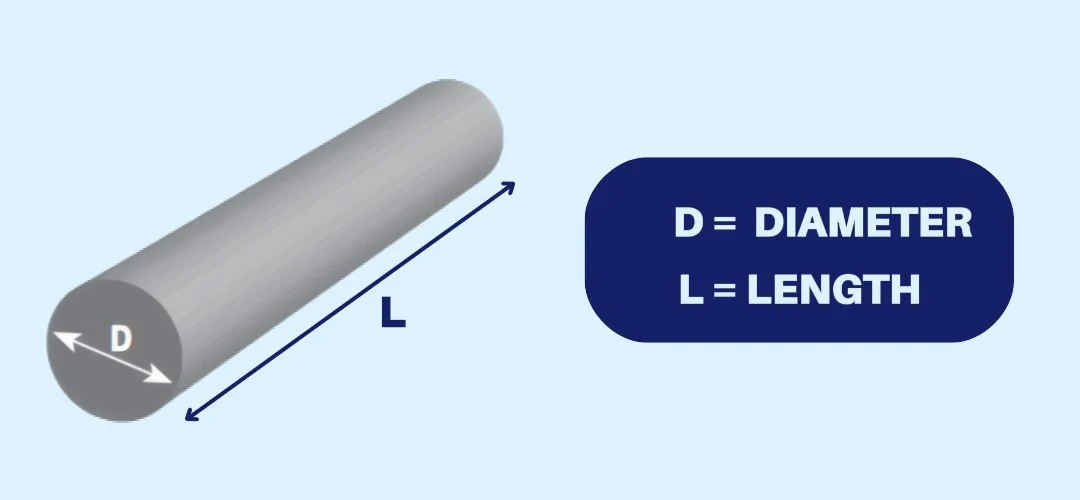
In the fields of mechanical engineering, manufacturing, and metal fabrication, precise knowledge of component weights is essential for successful planning, transportation, and structural analysis.
One of the most common components used in mechanical systems is the cylindrical shaft—a round solid metal rod that serves various roles, including transferring torque, supporting rotating parts, or serving as structural members.
A shaft is a long, cylindrical component typically made from solid metal. It can be straight or stepped and is often used in:
Power transmission systems
Rotating machinery
Axles and spindles
Structural supports
The weight of a shaft can significantly affect performance, load distribution, and structural integrity. Accurate shaft weight estimation is vital for both design and logistical purposes.
The Shaft Weight Calculator is a free online tool that helps you determine the mass of solid cylindrical shafts based on:
Material type (e.g., Steel, Aluminum, Copper)
Shaft diameter (in mm, cm, m, inches, or feet)
Length (in mm, cm, m, inches, or feet)
The tool outputs the results in three different units:
Kilograms (kg)
Pounds (lbs)
Metric Tons (tonnes)
It also provides the formula used, making it educational for students and professionals who want to learn the science behind the numbers.
The calculator is based on the volume formula of a cylinder:
Volume = π × (Diameter / 2)² × Length
The volume is then multiplied by the density of the selected material to determine the weight:
Weight = Volume × Density
The tool automatically converts all units to meters and uses standard industry density values in kg/m³.
You can choose from a wide range of materials including:
Mild Steel (7850 kg/m³)
Stainless Steel (8030 kg/m³)
Aluminum (2720 kg/m³)
Carbon Steel (7800 kg/m³)
Brass, Copper, Titanium, Cast Iron, Tool Steel, Lead, and more
This selection covers most use cases in engineering, manufacturing, and design.
Using the tool is straightforward:
Select Material: Choose your desired metal from the dropdown menu.
Enter Diameter: Input the diameter of the shaft and select its unit (e.g., mm, cm, in).
Enter Length: Input the length of the shaft and select its unit.
Click Calculate: Instantly view the shaft’s weight in kg, lbs, and tons.
You can also click “Reset” to clear the values and start a new calculation.
Example:
Material: Mild Steel (7850 kg/m³)
Diameter: 100 mm
Length: 2 meters
Step-by-step:
Convert diameter to meters: 100 mm = 0.1 m
Radius = 0.1 / 2 = 0.05 m
Volume = π × (0.05)² × 2 = 0.0157 m³
Weight = 0.0157 × 7850 = 123.20 kg
Pounds = 123.20 × 2.20462 = 271.66 lbs
Metric Tons = 123.20 / 1000 = 0.1232 tons
All these values will be shown in real-time by the calculator.
The calculator delivers accurate results instantly—no need for manual calculations or conversions.
Supports both metric and imperial units for input and output, making it suitable for global users.
The built-in formula display helps users understand the logic behind the weight calculation.
The tool is responsive and works well on smartphones, tablets, and desktops.
Knowing the weight of a shaft is critical in many scenarios:
Logistics & Shipping: Helps determine transport loads.
Structural Engineering: Supports load-bearing calculations.
Mechanical Design: Ensures proper function in rotating systems.
Inventory Estimation: Assists in stock planning and pricing.
Academic Use: Ideal for teaching basic physics and mechanical engineering.
An over- or under-estimated weight can lead to issues such as:
Overloading of structures or machinery
Poor balance in rotating systems
Incorrect costing in quotes or bids
Inefficient inventory and supply chain management
Using this calculator helps mitigate those risks with precision.
If you’re running a manufacturing or engineering-focused website, this calculator can also be embedded in your site to provide value to your audience. You can easily customize its size, style, and colors to match your branding.
From an SEO perspective, this calculator provides:
Evergreen traffic from engineering and metalworking professionals
Backlink opportunities from forums and blogs
Engagement signals through interactive functionality
Businesses can use this tool to improve user experience, gain trust, and establish domain authority.
The Shaft Weight Calculator is a fast, accurate, and reliable tool for anyone working with cylindrical metal components. By entering just a few parameters, you get instant weight values in multiple units.
It’s ideal for engineers, students, fabricators, and logistics managers who need precise data without doing lengthy calculations.
Try it now and save time on every shaft weight estimation.
Q1: Is the Shaft Weight Calculator accurate?
A: Yes, it uses standard geometric and density formulas used in engineering and physics for precise results.
Q2: Can I use this for hollow shafts?
A: This version is designed for solid cylindrical shafts. For hollow shafts, a separate calculator may be required.
Q3: Does the tool support imperial units?
A: Yes, you can input values in inches and feet and receive results in pounds as well.
Q4: Can I use this on mobile devices?
A: Absolutely. The calculator is fully responsive and works seamlessly on mobile, tablet, and desktop screens.
Explore the Engineer’s Guidebook! Find the latest engineering tips, industry insights, and creative projects. Get inspired and fuel your passion for engineering.
© 2023-2024 Engineer’s Guidebook. All rights reserved. Explore, Innovate, Engineer.